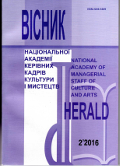РЕКЛАМНІ ВІДЕОРОЛИКИ ЯК ВИД АУДІОВІЗУАЛЬНОЇ ПРОДУКЦІЇ
DOI:
https://doi.org/10.32461/2226-3209.2.2016.138519Ключові слова:
реклама, рекламні відеоролики, відео кліпи, аудіовізуальний продуктАнотація
Мета роботи. Дослідження присвячене телевізійній рекламі як особливому виду аудіовізуальної продукції. В центрі уваги автора статті – аудіовізуальні рекламні відеоролики, їх класифікація та специфіка мистецтва створення. Методологія дослідження полягає в застосуванні методів спостереження, аналізу та теоретичного узагальнення даних практичної діяльності в галузі аудіовізуального мистецтва. Зокрема, телебачення – одного з засобів візуалізації рекламних відеороликів та найбільш ефективних методів звернення до споживача. Завдяки поєднанню звуку та зображення, спрямованій дії на глядача телебачення надає більші можливості ефективно впливати на споживача за короткий проміжок часу протягом перегляду різноманітних телепередач. Наукова новизна. Досліджено українські рекламні аудіовізуальні твори як культурний продукт сучасної України. Проаналізовано мистецтво створення аудіовізуального рекламного ролика та переглянуті різновиди аудіовізуальних рекламних творів. Висновки. Сучасна економіка та суспільство не можуть існувати без реклами. Відеорекламу до недавніх часів не вважали предметом наукового дослідження, оскільки не вбачали в ній ознак культурної продукції. Відеоролики – це новий вид аудіовізуальної мистецької продукції – аудіовізуальний міні-твір, короткометражний фільм, у якому стисло та зро-зуміло передається суть рекламного повідомлення. Автор доводить, що розробка реклами перетворюється на творчість, а рекламні відеоролики – на маленькі шедеври аудіовізуального мистецтва.
##submission.downloads##
Опубліковано
Номер
Розділ
Ліцензія
Автори, які публікуються у цьому журналі, погоджуються з наступними умовами:
1. Автори залишають за собою право на авторство своєї роботи та передають журналу право першої публікації цієї роботи на умовах ліцензії Creative Commons Attribution License International CC-BY, котра дозволяє іншим особам вільно розповсюджувати опубліковану роботу з обов'язковим посиланням на авторів оригінальної роботи та першу публікацію роботи у цьому журналі.
2. Автори мають право укладати самостійні додаткові угоди щодо неексклюзивного розповсюдження роботи у тому вигляді, в якому вона була опублікована цим журналом (наприклад, розміщувати роботу в електронному сховищі установи або публікувати у складі монографії), за умови збереження посилання на першу публікацію роботи у цьому журналі.
3.Політика журналу дозволяє і заохочує розміщення авторами в мережі Інтернет (наприклад, у сховищах установ або на особистих веб-сайтах) рукопису роботи, як до подання цього рукопису до редакції, так і під час його редакційного опрацювання, оскільки це сприяє виникненню продуктивної наукової дискусії та позитивно позначається на оперативності та динаміці цитування опублікованої роботи.

